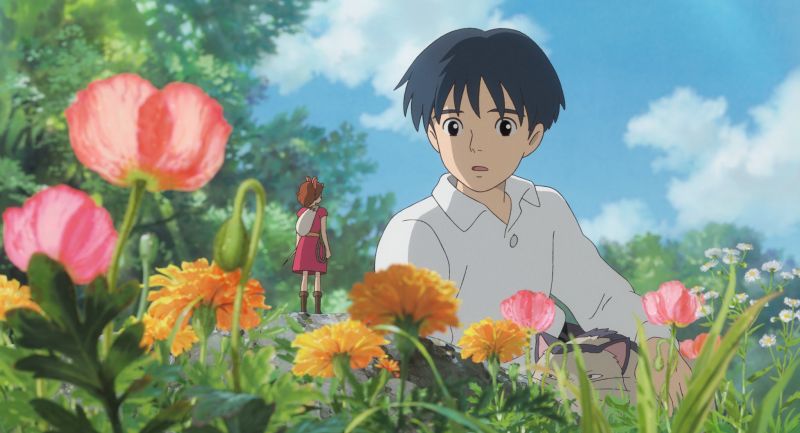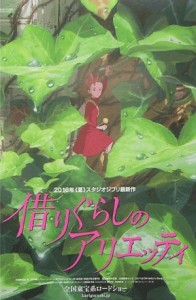[stextbox id=”grey” caption=”Arrietty (2010)” float=”true” align=”right” width=”200″]
Director: Hiromasa Yonebayashi
Runtime: 94 minutes
Starring: Mirai Shida, Ryunosuke Kamiki, Shinobu Otake
Country: Japan
Rating: Certified Bitstastic (?)
[/stextbox]
Studio Ghibli is often associated with the work of co-founder Hayao Miyazaki, yet the studio has produced a wealth of talent over the year. His groundbreaking work on Nausicaä of the Valley of the Wind led to the foundation of the studio, and along the way international success has followed with recognised masterpieces My Neighbour Totoro, Spirited Away and most recently Ponyo. Indeed, of the seventeen feature films produced under the Ghibli banner to date, only eight of these have been by Miyazaki himself, with bona fide classics from Isao Takahata such as Grave of the Fireflies and My Neighbours the Yamadas. Ghibli has also been a studio that is keen to foster new talent, including the debut of Tomomi Mochizuki with the experimental TV production Ocean Waves, Miyazaki’s own son with Tales of the Earthsea and the grooming of Whisper of the Heart‘s Yoshifumi Kondō before his tragic death in 1998. With Arrietty (借りぐらしのアリエッティ), the debut feature of Hiromasa Yonebayashi, Ghibli lets us know that the future is in safe hands.
Based on the series children’s novels by Mary Norton, the film shifts the setting to contemporary Koganei in western Tokyo, where a small family of “little people” live under the floorboards of a human house. Maintaining a good life by “borrowing” the objects, food and even electricity that the humans don’t need, young girl Arrietty (Mirai Shida, Daremo Mamotte Kurenai) is excited when her father Pod (Tomokazu Miura, Outrage) takes her on her first Borrowing. However, when Arrietty is spotted by Shō (Ryūnosuke Kamiki, Summer Wars), a largely bedridden boy with a heart condition, she becomes increasingly curious about the human world, changing the lives of everyone around her.
As the youngest director of a Studio Ghibli film, Hiromasa Yonebayashi was reportedly chosen for his animation style. Having worked as an animator on Ghibli films since 1997′s Princess Mononoke, and as a key animator on films such as Howl’s Moving Castle, Yonebayashi has a keen visual sense. The animation, supervised by Miyazaki himself, is gorgeously detailed, with every frame oozing with lush imagery. Maintaining the strong hand-drawn aesthetic that has never left Ghibli, even as animation houses the world over convert entirely to digital and CGI, Arrietty maintains the charms of traditional animation, and it slots easily into the breezy world of the Borrowers. Nothing appears to be placed randomly on screen, with even the busiest of sets filled with the kind of loving detail that artisans devote to their craft. Shown from the perspective of a group of people only 10cm tall, there is a photo-realistic weight to the painted backgrounds, and an all-encompassing world that makes the everyday seem marvellous again, much like the first time Pixar’s Toy Story was first screened to the world.
Unlike the 1997 live action adaptation of The Borrowers, or even the BBC serial of the same name, Arrietty doesn’t come across as a recently unbottled genie full of kinetic energy, but rather has a gentle pace that is more reminiscent of the simpler thrills of the original setting of the 1950s. Despite the contemporary setting, and the young director at the helm, there is a corresponding innocence that both children and adults will respond to. Much like Ghibli’s earlier work, there is a strong environmental message that makes itself known in the second half of the film, as the little people begin to realise that they are an endangered species. Indeed, there are certainly parallels with Ghibli’s last film, Ponyo, and elements of that film’s fairytale inspiration, such as The Little Mermaid, lingering within, particularly in the overprotective father figure. Yet where those earlier films tend to build to a action-packed finale, Arrietty is the antithesis of hurried. While the threat of humans looms large for some of the film, even Shō’s heart condition never proves to be too much of a going concern, making this a gentle ride to the last.
Winner of the Animation of the Year at the 34th Japan Academy Prize, Arrietty evokes the history of Japanese animation while simultaneously forging something new. While some of the traditional elements of the Ghibli film are absent, notably Miyazaki himself and regular composer Joe Hisaishi (with duties taken on by French musician Cécile Corbel), the film captures the magic of those earlier films and carves out a niche of its own in this sure to be timeless classic.
[stextbox id=”custom”]Arrietty never reaches the epic heights of some of Ghibli’s previous efforts because it doesn’t have. A wonderful debut from Yonebayashi, who has the promise of being a worthy successor to the likes of Miyazaki when he eventually retires.[/stextbox]
Arrietty is screening on 26 November (Sydney) and 4 December (Melbourne) 2011 at the 15th Japanese Film Festival in Australia. It will be released in the US as The Secret World of Arrietty from 17 February 2012 from Disney. It will also be released on 1 January 2012 in Australia theatrically from Madman.







